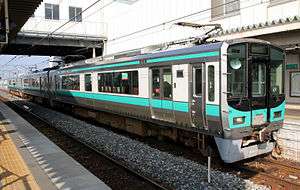125 series
The 125 series (125系, 125-kei) is a single-car DC electric multiple unit (EMU) train type operated by West Japan Railway Company (JR-West) on local services in Japan since March 2003.[1]
| 125 series | |
|---|---|
 Kakogawa Line KuMoHa 125-12 in March 2008 | |
| Manufacturer | Kawasaki Heavy Industries |
| Built at | Hyogo |
| Constructed | 2002–2006 |
| Entered service | March 2003 |
| Number built | 18 cars |
| Number in service | 18 cars |
| Formation | Single car unit |
| Fleet numbers | F1–8, F13–18, N1–4 |
| Capacity | 117 |
| Operator(s) | JR-West |
| Depot(s) | Tsuruga, Aboshi |
| Line(s) served | Obama Line, Maizuru Line, Kakogawa Line |
| Specifications | |
| Car body construction | Stainless steel |
| Car length | 20,340 mm (66 ft 9 in) |
| Width | 2,950 mm (9 ft 8 in) |
| Height | 4,095 mm (13 ft 5.2 in) |
| Doors | 2 pairs per side |
| Maximum speed | 120 km/h (75 mph) |
| Traction system | Variable frequency (2-level IGBT) |
| Power output | 440 kW |
| Electric system(s) | 1,500 V DC overhead line |
| Current collection method | WPS28A single-arm pantograph |
| Bogies | WDT59A (motored), WTR243B (trailer) |
| Safety system(s) | ATS-P |
| Track gauge | 1,067 mm (3 ft 6 in) |
Design
The 125 series design is based on the 223-2000 series EMU design, with stainless bodies and steel front ends.[1]
The cars have two pairs of sliding doors on each side, with provision for a third set of doors in the centre.[1]
The second-batch cars (KuMoHa 125-9–12) delivered in 2003 differ from the earlier batch by having enlarged front-end skirts and darker grey tinted windows.[1]
Operations
The 125 series is used on wanman driver-only operation services, primarily on the Obama Line and Kakogawa Line.[1]
Up to five single cars can be operated together as a multiple car set.[1]
Formation
| Designation | cMc |
|---|---|
| Numbering | KuMoHa 125 |
| Capacity (Seated/standing) |
31/86 |
| Weight | 40.5 t |
Cars KuMoHa 125-7/8/11/12 are equipped with a second de-icing pantograph.[2]
Interior
Passenger accommodation consists of longitudinal bench seating at the ends, and 2+2 abreast transverse reversible seating in the centre of the cars.[1] The first two batches of cars (KuMoHa 125-1–12) were delivered with 1+2 abreast seating, but this was increased to 2+2 seating during 2003 and 2004.[2]
- General view of interior (KuMoHa 125-16, April 2008)
- Reversible seating (KuMoHa 125-16, April 2008)
- Priority seating (KuMoHa 125-16, April 2008)
- Doorway and toilet (KuMoHa 125-16, April 2008)
History
The first eight cars (KuMoHa 125-1–8) were built by Kawasaki Heavy Industries in December 2002 for entry into service from 15 March 2003 on the newly electrified 84.3 km Obama Line between Tsuruga and Higashi-Maizuru.[2] These sets were initially allocated to Fukuchiyama Depot, but were subsequently transferred to Tsuruga Depot.[1]
Four more cars (KuMoHa 125-9–12) were built in September 2004 for entry into service from 19 December 2004 on the newly electrified 48.5 km Kakogawa Line between Kakogawa and Tanikawa.[2]
A further six cars (KuMoHa 125-13–18) were built in September 2006 to coincide with the conversion of Tsuruga area services from 20 kV AC to 1,500 DC electrification from 21 October 2006.[1][2]
Further reading
- 125系一般形直流電車 [125 series DC EMU]. Japan Railfan Magazine (in Japanese). 43 (503): 61–65. March 2003.
References
- JR全車輌ハンドブック2009 [JR Rolling Stock Handbook 2009]. Japan: Neko Publishing. 2009. p. 258/611. ISBN 978-4-7770-0836-0.
- JR電車編成表 2011夏 [JR EMU Formations - Summer 2011]. Japan: JRR. May 2010. p. 142/180. ISBN 978-4-330-21211-1.
| Wikimedia Commons has media related to 125 series. |